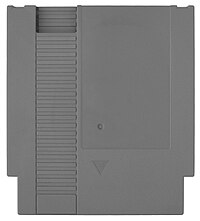Our website is made possible by displaying online advertisements to our visitors.
Please consider supporting us by disabling your ad blocker.
List of Nintendo Entertainment System games
The Nintendo Entertainment System has a library of 1376[a] officially licensed games released for the Japanese version, the Family Computer (Famicom), and its international counterpart, the NES, during their lifespans, plus 7 official multicarts and 2 championship cartridges. Of these, 672 were released exclusively in Japan, 187 were released exclusively in North America, and 19 were released exclusively in PAL countries. Worldwide, 521 games were released.
Its launch games for the Famicom were Donkey Kong, Donkey Kong Jr., and Popeye. Only first-party titles were available upon launch, but Nintendo started a licensing program the following year that allowed third-party companies such as Namco, Hudson Soft, Taito, Konami, Bandai, and Capcom to create titles and produce their own cartridges for the Famicom in exchange for royalty payments;[1][2] Nintendo later revised the program to mandate itself as the producer of all cartridges while carrying it with the console outside Japan.[3][4] The launch games for North America were: 10-Yard Fight, Baseball, Clu Clu Land, Duck Hunt, Excitebike, Golf, Gyromite, Hogan's Alley, Ice Climber, Kung Fu, Pinball, Soccer, Stack-Up, Super Mario Bros., Tennis, Wild Gunman, and Wrecking Crew.[5][6][b] The final licensed game released is the PAL-exclusive The Lion King on May 25, 1995.
As was typical for consoles of its era, the Famicom used ROM cartridges as the primary method of game distribution;[7] each cartridge featured 60 pins, with two pins reserved for external sound chips.[8][9] For the console's North American release in 1985 as the Nintendo Entertainment System, Nintendo redesigned the cartridge to accommodate the console's front-loading, videocassette recorder-derived socket by nearly doubling its height and increasing its width by one centimeter (0.39 in), resulting in a measurement of 13.3 cm (5.2 in) high by 12 cm (4.7 in) wide.[10]: 108 [11] Referred to as "Game Paks", each NES cartridge sported an increased total of 72 pins, with two pins reserved for the CIC lockout chip and ten pins reserved for connections with the console's bottom expansion port.[10]: 367 However, the two pins for external sound were removed and relocated to the expansion port instead; any Famicom game using them would have its soundtrack recomposed for releases on NES cartridges.[9][12] Though the extra space of the NES cartridge was not utilized by most games, it enabled the inclusion of additional hardware expansions; in contrast, some copies of early NES games like Gyromite merely paired the printed circuit board of the game's Famicom version with an adapter to convert between the different pinouts.[10]: 108 [13]
Nintendo later released the Famicom Disk System (FDS) in Japan in 1986, intending to have developers distribute all future games on proprietary 2.8-inch (7.1 cm) floppy disks to avoid the cost and size limitations of cartridges; however, developers began re-releasing FDS games on cartridges as advancements in cartridge technology made them feasible again with the limitations of the floppy disks and their ecosystem apparent, pulling support for the FDS by the 1990s.[9]
Cite error: There are <ref group=lower-alpha> tags or {{efn}} templates on this page, but the references will not show without a {{reflist|group=lower-alpha}} template or {{notelist}} template (see the help page).
- ^ Sheff, David (1993). Game Over. New York: Random House. pp. 60–62. ISBN 0-679-40469-4.
- ^ Kurokawa, Fumio (March 17, 2018). "ビデオゲームの語り部たち 第4部:石村繁一氏が語るナムコの歴史と創業者・中村雅哉氏の魅力" [Video game storytellers Part 4: The history of Namco and the charm of its founder, Masaya Nakamura, talked about by Shigekazu Ishimura]. 4Gamer (in Japanese). Archived from the original on August 1, 2019. Retrieved January 22, 2025.
- ^ McFerran, Damien (January 30, 2017). "Namco Founder Masaya Nakamura Dies Aged 91". Nintendo Life. Archived from the original on August 28, 2019. Retrieved January 22, 2025.
- ^ Mochizuki, Takahashi; Savov, Vlad (August 25, 2020). "Epic's Battle With Apple and Google Actually Dates Back to Pac-Man". Bloomberg News. Archived from the original on November 6, 2021. Retrieved January 22, 2025.
- ^ a b Semrad, Edward J. (October 5, 1985). "New Nintendo system way ahead of the field". The Milwaukee Journal. Retrieved September 12, 2024.
- ^ a b c Dayton, David (October 18, 2010). "Super Mario's Release Date is Missing!". The Mushroom Kingdom. Archived from the original on July 7, 2013. Retrieved October 8, 2011.
- ^ Packwood, Lewis (July 18, 2023). "40 years of the Nintendo Famicom – the console that changed the games industry". The Guardian. Retrieved January 6, 2024.
- ^ Cunningham, Andrew (July 15, 2013). "The NES turns 30: How it began, worked, and saved an industry". Ars Technica. Condé Nast. Archived from the original on December 2, 2017. Retrieved January 5, 2024.
- ^ a b c Bivens, Danny (October 26, 2011). "Famicom Disk System". Nintendo World Report. Nintendo's Expansion Ports. Archived from the original on June 19, 2014. Retrieved September 6, 2022.
- ^ a b c Altice, Nathan (2015). I Am Error: The Nintendo Family Computer/Entertainment System Platform. MIT Press. ISBN 978-0-262-02877-6. Archived from the original on January 11, 2020. Retrieved January 6, 2024 – via Google Books.
- ^ Packwood, Lewis (February 28, 2020). "NES Creator Reveals The "Shocking" Story Behind That Infamous Flap". Nintendo Life. Archived from the original on November 15, 2021. Retrieved January 6, 2024.
- ^ Edwards, Benj (March 10, 2006). "Japanese Castlevania III: The Music is Worth it". Vintage Computing and Gaming. Retrieved July 22, 2010.
- ^ Edwards, Benj (November 14, 2005). "How to Tell if a Copy of Gyromite has a Famicom Adapter in it". Vintage Computing and Gaming. Retrieved October 20, 2008.
Previous Page Next Page
Roll c'hoarioù NES BR Llista de videojocs de NES Catalan Liste der Nintendo-Entertainment-System-Spiele German Anexo:Videojuegos para NES Spanish Luettelo Nintendo Entertainment System -peleistä Finnish Liste de jeux Nintendo Entertainment System French Lijst van NES-spellen Dutch Lista gier wydanych na konsolę Nintendo Entertainment System Polish Lista de jogos para Nintendo Entertainment System Portuguese Проект:Компьютерные игры/Списки/Игр на NES Russian






